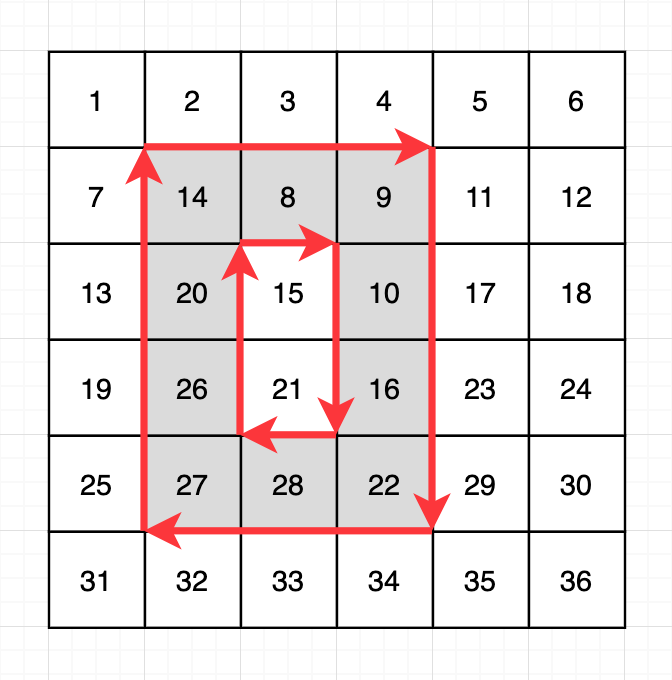4. 행렬 테두리 회전하기
문제 설명
rows*columns 크기의 행렬.
(x1, y1, x2, y2)의 형태로 두개의 지점을 정하면 해당 사각형 테두리에 있는 숫자들을 시계방향으로 하나씩 shift 한다.

이러한 쿼리를 모두 처리한 뒤에 위치가 변경된 숫자들 중 가장 작은 숫자를 어레이에 담아 리턴.
Inputs
| Variable Name | type | meaning |
|---|---|---|
| rows | Int | matrix rows |
| columns | Int | matrix columns |
| queries | Vector[Vector[Int]] | query that shows 4 numbers to make box for rotation. |
output
return Vector[Int] // changed numbers sorted by ascending order
Conditions
- rows & columns: 2~100
- initial matrix is looks like (eg)
- [1 2 3 4 5] [6 7 8 9 10] …
- quries
- length: 1~10 000
- first applied first.
- query
- 1 ≤ x1 ≤ x2 ≤ rows
- 1 ≤ y1 ≤ y2 ≤ columns
Test cases
| rows | columns | queries | result |
|---|---|---|---|
6 |
6 |
[[2,2,5,4],[3,3,6,6],[5,1,6,3]] |
[8, 10, 25] |
3 |
3 |
[[1,1,2,2],[1,2,2,3],[2,1,3,2],[2,2,3,3]] |
[1, 1, 5, 3] |
100 |
97 |
[[1,1,100,97]] |
[1] |
Solution
Idea1
일단 초기 어레이 형태를 생성. queries에 map걸고 변환.
def updateMatrix(box: Vector[Int], matrix: Vector[Vector[Int]]): Vector[Vector[Int]] = {
val start = (box(0)-1, box(1)-1)
val end = (box(2)-1, box(3)-1)
return matrix.zipWithIndex
.map{case(row, row_idx) =>
row.zipWithIndex
.map{case(v, col_idx) =>
if (row_idx == start._1 && start._2 < col_idx && col_idx <= end._2) {
// top row (other than left corner) -> refers one left, same row
matrix(row_idx)(col_idx-1)
} else if (row_idx == end._1 && start._2 <= col_idx && col_idx < end._2) {
// bottom row (other than right corner) -> refers one right, same row
matrix(row_idx)(col_idx+1)
} else if (col_idx == end._2 && start._1 < row_idx && row_idx <= end._1) {
// right col (other than top corner) -> refers one top, same col
matrix(row_idx-1)(col_idx)
} else if (col_idx == start._2 && start._1 <= row_idx && row_idx < end._1) {
// left col (other than bottom corner) -> refers one below, same col
matrix(row_idx+1)(col_idx)
} else v
}
}
}
def getDiffMin(box: Vector[Int], matrix: Vector[Vector[Int]]): Int = {
val start = (box(0)-1, box(1)-1)
val end = (box(2)-1, box(3)-1)
val trans = matrix.transpose
var arr = Vector[Int]()
arr = arr.appendedAll(matrix(start._1).slice(start._2, end._2))
arr = arr.appendedAll(matrix(end._1).slice(start._2+1, end._2+1))
arr = arr.appendedAll(trans(end._2).slice(start._1, end._1))
arr = arr.appendedAll(trans(start._2).slice(start._1+1, end._1+1))
return arr.filter(v => v != -1).min
}
def solution(rows: Int, columns: Int, queries: Vector[Vector[Int]]): Vector[Int] = {
var initMatrix = Vector.tabulate(rows, columns){ (i,j) => rows*i + j+1 }
var convMatrix = Vector.tabulate(rows, columns){ (i,j) => rows*i + j+1 }
var ans = Vector[Int]()
for(query <- queries){
// initMatrix = convMatrix
convMatrix = updateMatrix(query, convMatrix)
ans = ans :+ getDiffMin(query,
convMatrix.zip(initMatrix)
.map{case(convRow, initRow) =>
convRow.zip(initRow)
.map{case(c, i) => if (c != i) c else -1}
}
)
}
return ans
}
제출 테스트에서 2개 빼고 다 틀린다… 로직이 틀린듯. 다시 풀자.
Idea2
회전에 의해 위치가 바뀌었다. → 이문장을 잘 이해해야할 거 같다.
가 아니라 최초에 메트릭스 생성을 잘못했다 ㅋㅋㅋㅋㅋ 아니 진짜 나 뭐해.
tabulate로 생성할때 rows x i + j +1이 아니라 columns x i + j + 1이다.
def solution(rows: Int, columns: Int, queries: Vector[Vector[Int]]): Vector[Int] = {
var matrix = Vector.tabulate(rows, columns){ (i,j) => columns*i+j +1 }
var smallest = Vector[Int]()
for (query <- queries) {
// var query = queries(0)
var rotationTarget = Vector[Int]()
var tmp = matrix
val x1 = query(0) - 1
val y1 = query(1) - 1
val x2 = query(2) - 1
val y2 = query(3) - 1
for (c <- y1+1 to y2) {
// x1 top row (other than left corner) -> refers one left, same row
rotationTarget = rotationTarget:+matrix(x1)(c-1)
tmp = tmp.updated(x1, tmp(x1).updated(c, matrix(x1)(c-1)))
}
for (c <- y1 to y2-1) {
// x2 bottom row (other than right corner) -> refers one right, same row
rotationTarget = rotationTarget:+matrix(x2)(c+1)
tmp = tmp.updated(x2, tmp(x2).updated(c, matrix(x2)(c+1)))
}
for (r <- x1+1 to x2) {
// y2 right col (other than top corner) -> refers one top, same col
rotationTarget = rotationTarget:+matrix(r-1)(y2)
tmp = tmp.updated(r, tmp(r).updated(y2, matrix(r-1)(y2)))
}
for (r <- x1 to x2-1) {
// y1 left col (other than bottom corner) -> refers one below, same col
rotationTarget = rotationTarget:+matrix(r+1)(y1)
tmp = tmp.updated(r, tmp(r).updated(y1, matrix(r+1)(y1)))
}
smallest = smallest:+rotationTarget.min
matrix = tmp
}
return smallest
}
Idea3
기존의 코드에서 최초 행렬 생성만 수정해보자 → 아주 잘작동한다. 허허. 왜 제일 중요한 기본적인걸 확인안했을 까 ㅠㅠ
Study from Implementation
- 벡터의 값을 변경하려면 무조건 updated 메소드를 사용해야한다.
- 이게 생각보다 불편하다
- 벡터에 append하는 방법은
- 벡터 :+ 단일값
- 벡터.appendedAll(벡터 with 복수값)